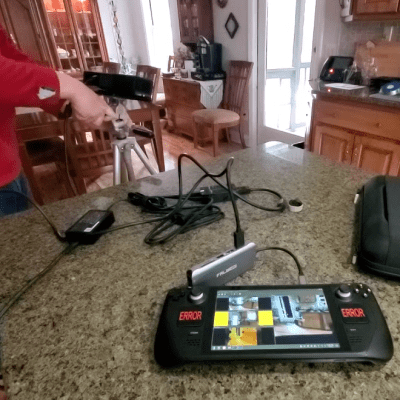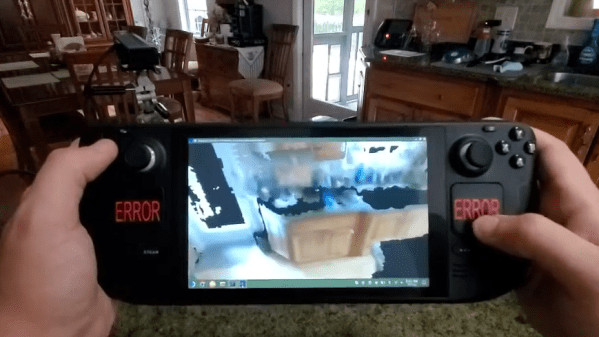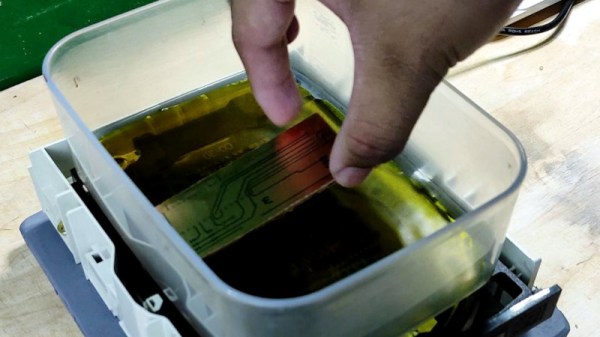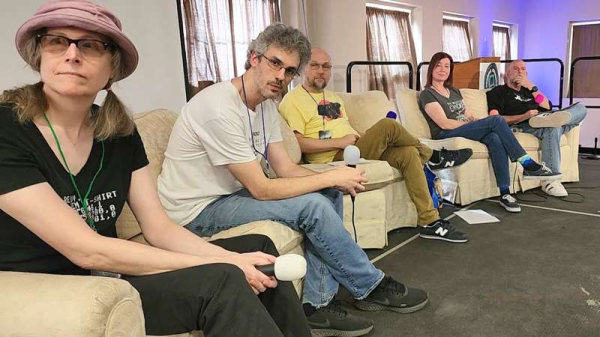Off-the-shelf stock parts are the blocks from which we build mechanical projects. And while plenty of parts have dedicated uses, I enjoy reusing them in ways that challenge what they were originally meant for while respecting the constraints of their construction. Building off of my piece from last time, I’d like to add to your mechanical hacking palette with four more ways we can re-use some familiar off-the-shelf parts. Continue reading “The BSides: More Curious Uses Of Off-the-shelf Parts”
3D Scanning A Room With A Steam Deck And A Kinect
It may not be obvious, but Valve’s Steam Deck is capable of being more than just a games console. Demonstrating this is [Parker Reed]’s experiment in 3D scanning his kitchen with a Kinect and Steam Deck combo, and viewing the resulting mesh on the Steam Deck.

[Parker] runs the RTAB-Map software package on his Steam Deck, which captures a point cloud and color images while he pans the Kinect around. After that, the Kinect’s job is done and he can convert the data to a mesh textured with the color images. RTAB-Map is typically used in robotic applications, but we’ve seen it power completely self-contained DIY 3D scanners.
While logically straightforward, the process does require some finessing and fiddling to get it up and running. Reliability is a bit iffy thanks to the mess of cables and adapters required to get everything hooked up, but it does work. [Parker] shows off the whole touchy process, but you can skip a little past the five minute mark if you just want to see the scanning in action.
The Steam Deck has actual computer chops beneath its games console presentation, and we’ve seen a Steam Deck appear as a USB printer that saves received print jobs as PDFs, and one has even made an appearance in radio signal direction finding.
Continue reading “3D Scanning A Room With A Steam Deck And A Kinect”
OSI Superboard II Replicated
While our modern computer can easily emulate a lot of different old machines, there is something about having replica hardware that is even better. Not as nice as having the real thing, in some ways, although you don’t have to worry about wear and tear on a replica, either. [Jeff Tranter] has built a kit replica of an Ohio Scientific Superboard II, and it looks great, as you can see in the video below.
This was an inexpensive all-in-one 6502 computer with a keyboard and provision for TV or monitor output. If you had a 5V power supply, a cassette deck, and a TV you were in business for less money than most of the comparable alternatives. In fact, [Jeff] has the canceled check where his parents paid $486 Canadian for one in 1981. That was his introduction to computing, and we’d say that was a reasonable investment on the part of his parents.
Rickrolling SSID With ESP32
Reddit user [nomoreimfull] posted code for a dynamic WiFi beacon to r/arduino. The simple, but clever, sketch is preloaded with some rather familiar lyrics and is configured to Rickroll wireless LAN users via the broadcast SSID (service set identifier) of an ESP32 WiFi radio.
The ESP32 and its smaller sibling the ESP8266 are tiny microcontrollers that featuring built-in WiFi support. With their miniature size, price, and power consumption characteristics, they’ve become favorites for makers, hackers, and yes pranksters for a wide variety of projects. They can be easily programmed using their own SDK or through a “board support” extension to the Arduino IDE.
For the dynamic WiFi beacon, the ESP32 is placed into AP (access point) mode and broadcasts its human readable name (SSID) as configured. What makes the SSID dynamic, or rolling, is that the sketch periodically updates the SSID to a next line of text stored within the code. Of course, in the Rickroll prank this means the next line of lyrics from “Never Gonna Give You Up” by Rick Astley himself.
Always a favorite prank, we’ve seen Rickrolls take the form of IR remote controls , free WiFi servers, and coin cell throwies.
Rick Astley picture: Wjack12, CC BY-SA 4.0.
Shake Your PCB Etching, With An Old Optical Drive
Easy PCB fabrication in China has revolutionised electronic construction at our level, but there are still times when it makes sense to etch your own boards. It’s a messy business that can also be a slow one, but at least a project from [earldanielph] takes away one chore. It agitates the etchant solution round the board, by moving the tank backwards and forwards on the drawer of an old optical drive.
The first part of the build is simply removing all parts of the drive except the drawer mechanism and its motor. This is still, in most cases, a DC motor, so an Arduino can easily drive it with a motor control shield. It’s worth a moment to reflect on how little there is to a modern optical drive.
The Arduino receives a sketch that moves the tray backward and forward, and a piece of ply is attached to the tray. This becomes a stand for a plastic tub containing the etchant and board, and the liquid is soon swishing back and forwards over the surface. You can see the result in the video below the break. Definitely a saving over manual agitation. It’s an inventive machine, but it’s not the first PCB agitator we’ve seen.
Continue reading “Shake Your PCB Etching, With An Old Optical Drive”
Hackaday Links: April 23, 2023
Mark it on your calendars, folks — this is the week that the term RUD has entered the public lexicon. Sure, most of our community already knows the acronym for “rapid unscheduled disassembly,” and realizes its tongue-in-cheek nature. But given that the term has been used by Elon Musk and others to describe the ignominious end of the recent Starship test flight, it seems like RUD will catch on in the popular press. But while everyone’s attention was focused on the spectacular results of manually activating Starship’s flight termination system to end its by-then uncontrolled flight at a mere 39 km, perhaps the more interesting results of the launch were being seen in and around the launch pad on Boca Chica. That’s where a couple of hundred tons of pulverized reinforced concrete rained down, turned to slag and dust by the 33 Raptor engines on the booster. A hapless Dodge Caravan seemed to catch the worst of the collateral damage, but the real wrath of those engines was focused on the Orbital Launch Mount, which now has a huge crater under it.
VCF East 2023: Retro Luminaries Take The Stage
Our friend [Fran Blanche] recently recorded what it was like to participate in an energetic round table at the recently held Vintage Computer Festival (VCF) East. Fran joined well known personalities [Jeri Ellsworth], [Adrian Black] of Adrian’s Digital Basement, and Usagi Electric creator [Dave Lovett] with yours truly moderating.
The table-less roundtable discussed the pros and cons of streaming about retro and tech, and what its like to hang yourself out there in video format. Goals and motives differed widely from speaker to speaker and there was some good-natured ribbing about who makes money vs. who simply gets away with spending less.
Most of all fun was had by the speakers as they interacted with each other, and with the audience — and that comfort came across to the standing room only crowd of avid retro-enthusiasts who only told us good things about what they saw and heard that night.
One thing we did note was that every speaker actually knew what microphones were and how to use them.
Want to learn more about the 2023 Vintage Computer Festival East? You can start by checking out our previous coverage, and don’t miss the first in a series of fascinating interviews recorded by the Hackaday crew as they explored this phenomenal retrocomputing event.
Continue reading “VCF East 2023: Retro Luminaries Take The Stage”


















